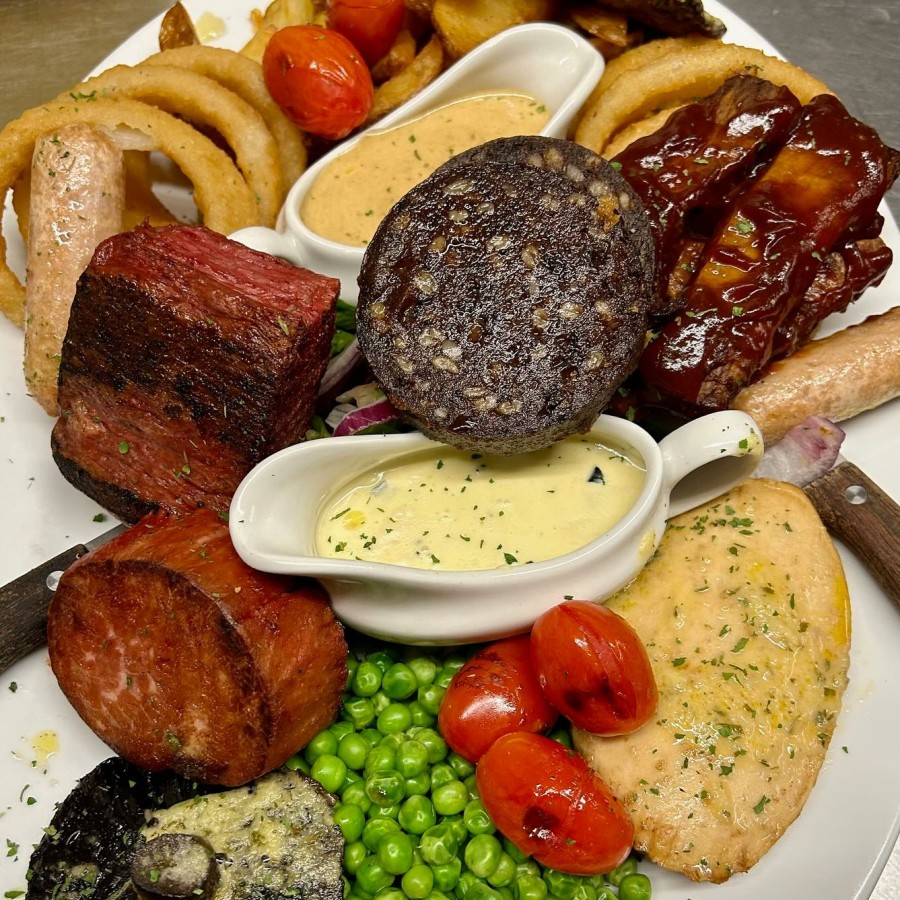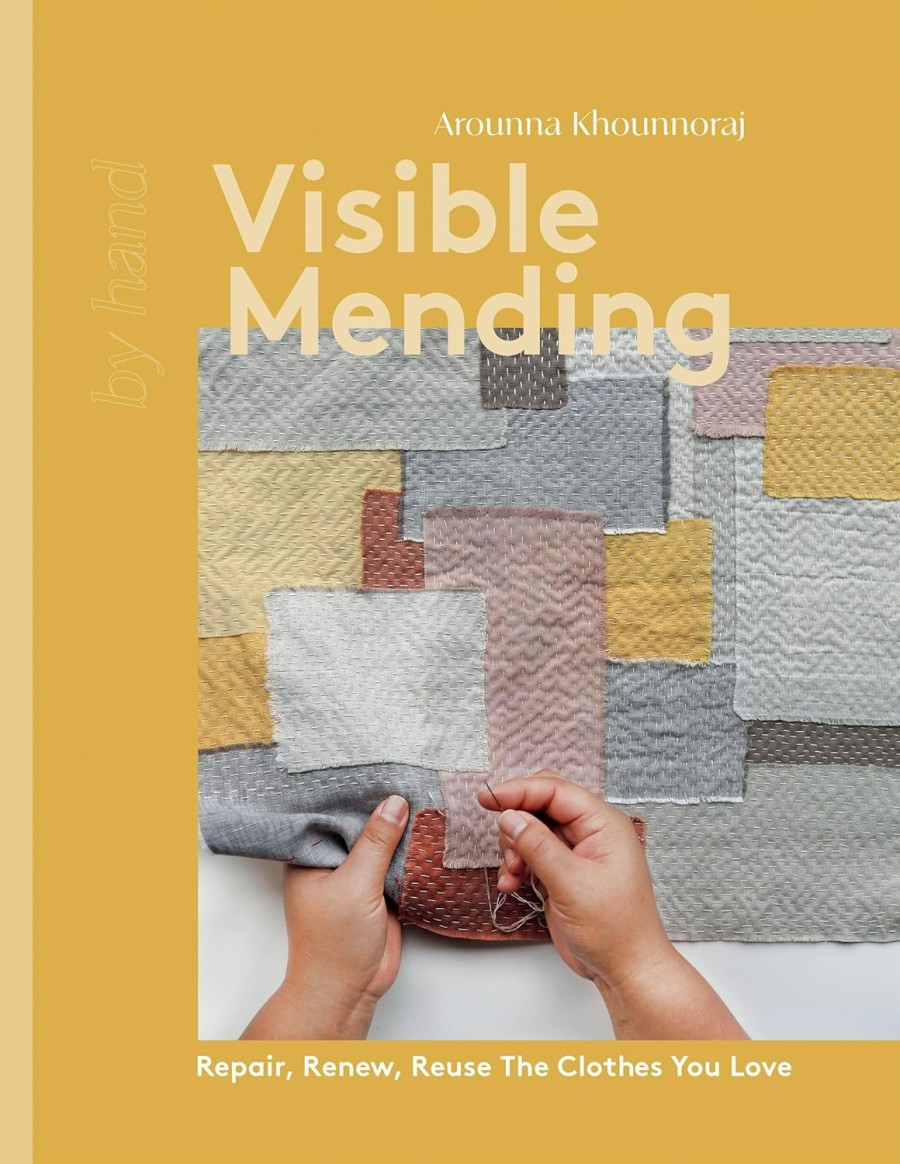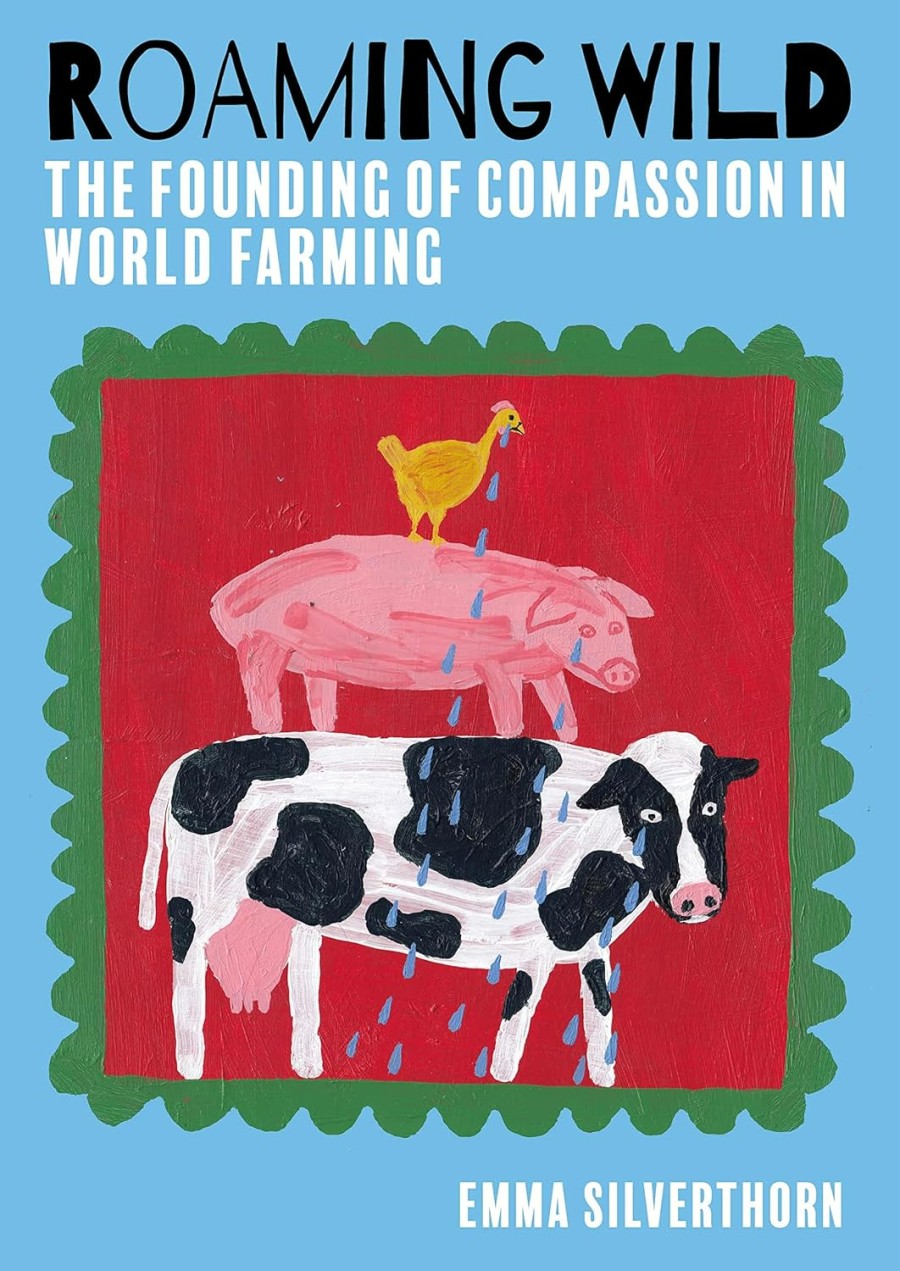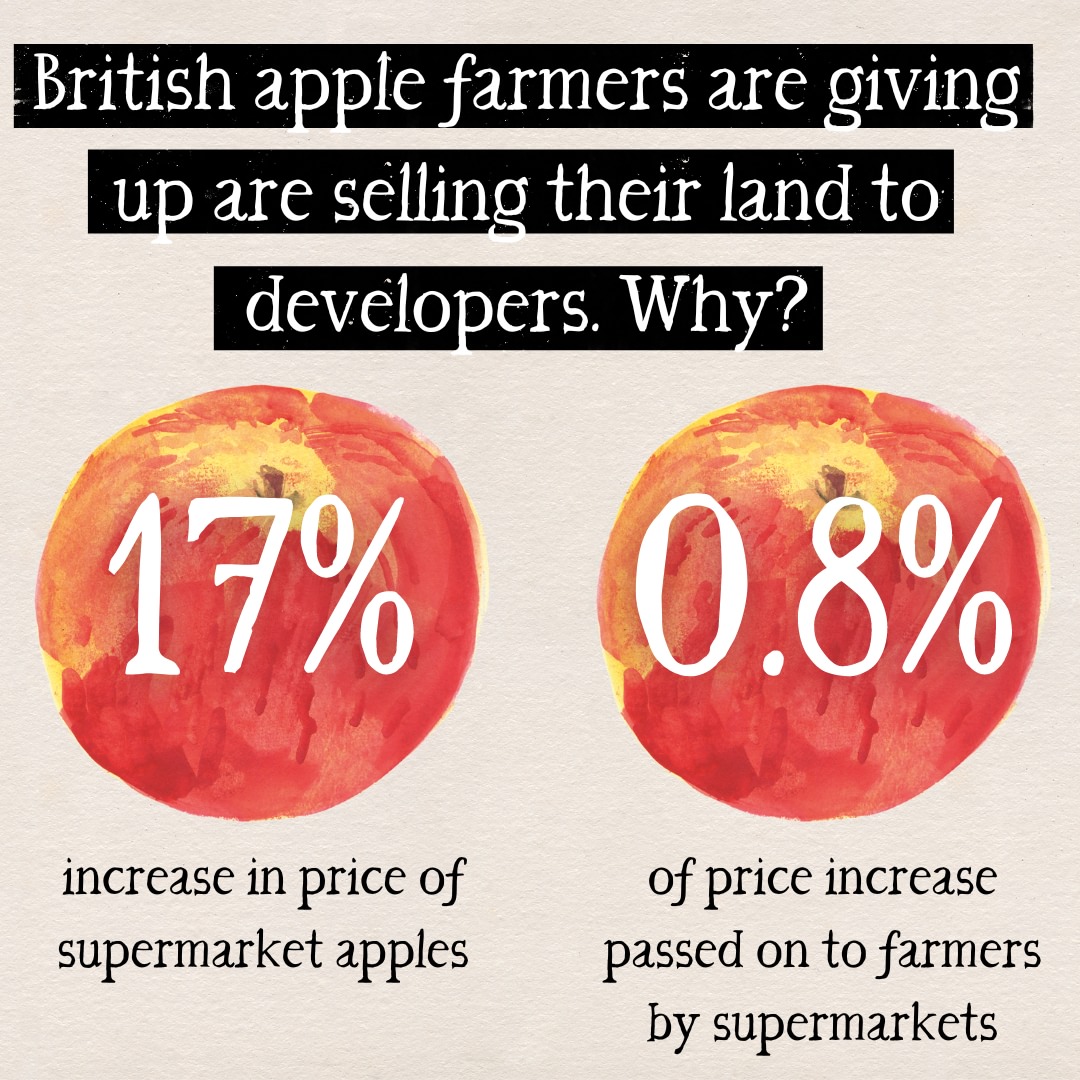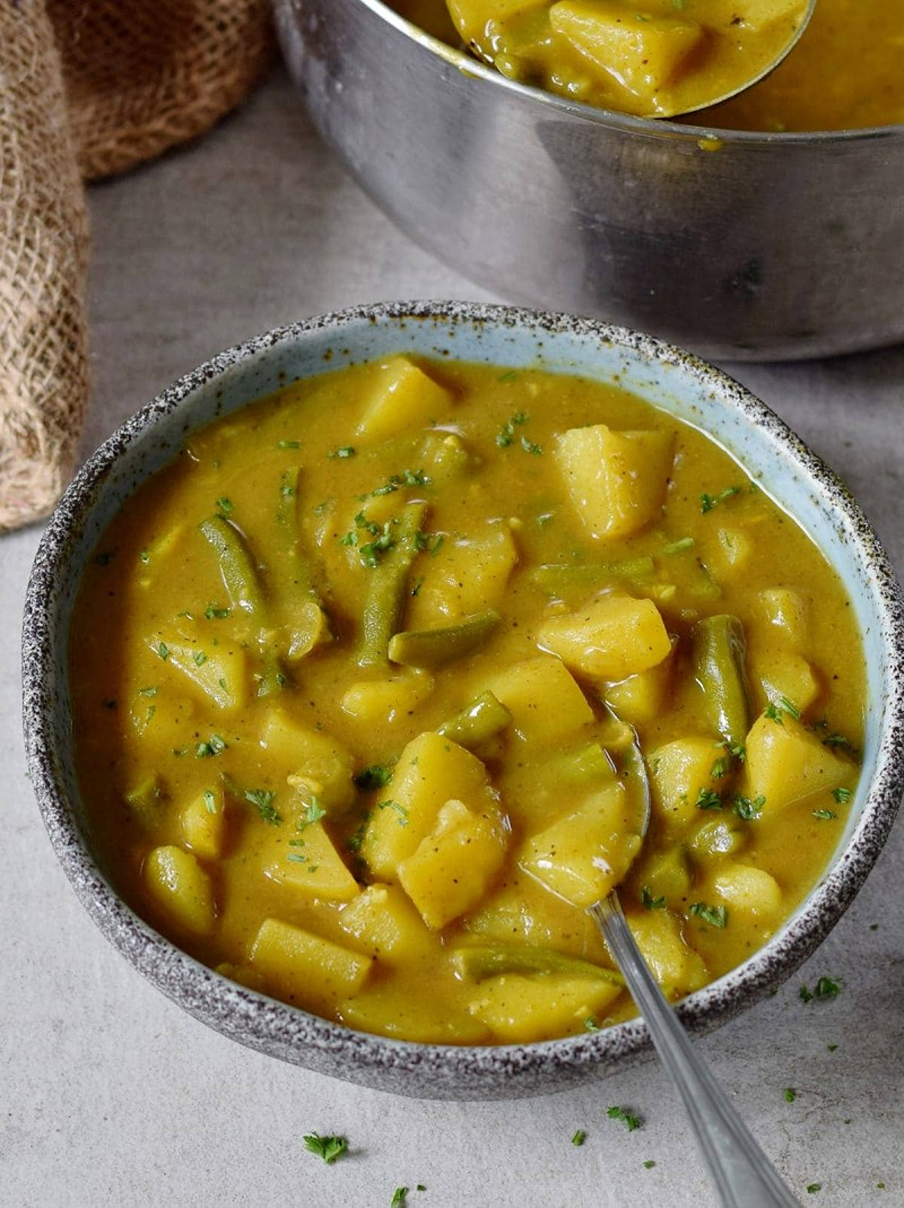
Did you know that the official favourite meal in England is now not a Sunday roast – but the Balti curry? Born in Birmingham! There are many types of curry, and here are just a few super-simple affordable recipes (made with ingredients you can find in any store) to make your own. Homemade curry is good because you know what’s in it, it’s cheaper than buying supermarket ready-made curries (in plastic packaging) and most people can’t afford take-out curries on a regular basis.
If you love spuds and love curry, try this potato curry (Ela Vegan). Again it uses canned coconut milk alongside Yukon gold potatoes, onion and garlic with green beans, veggie broth and fresh ginger. Garnish with fresh herbs.
Read keeping people & pets safe in the kitchen. Many human foods (including spices and fresh dough for naan bread) are unsafe around animal friends.
England has thousands of curry houses (two-thirds of all our take-out orders are for Indian meals and millions of poppadums! Like Italy, there is no such thing as ‘Indian food’. Everything is regional. People in southern India are more likely to be vegetarian due to religious beliefs, and in the north the culture is more Muslim, so people eat different kinds of curries.
let’s go to curry university!
So what exactly is curry? Obviously it has origins in India (though there are different types of curry including Japanese, Thai and Indonesian curry dishes).
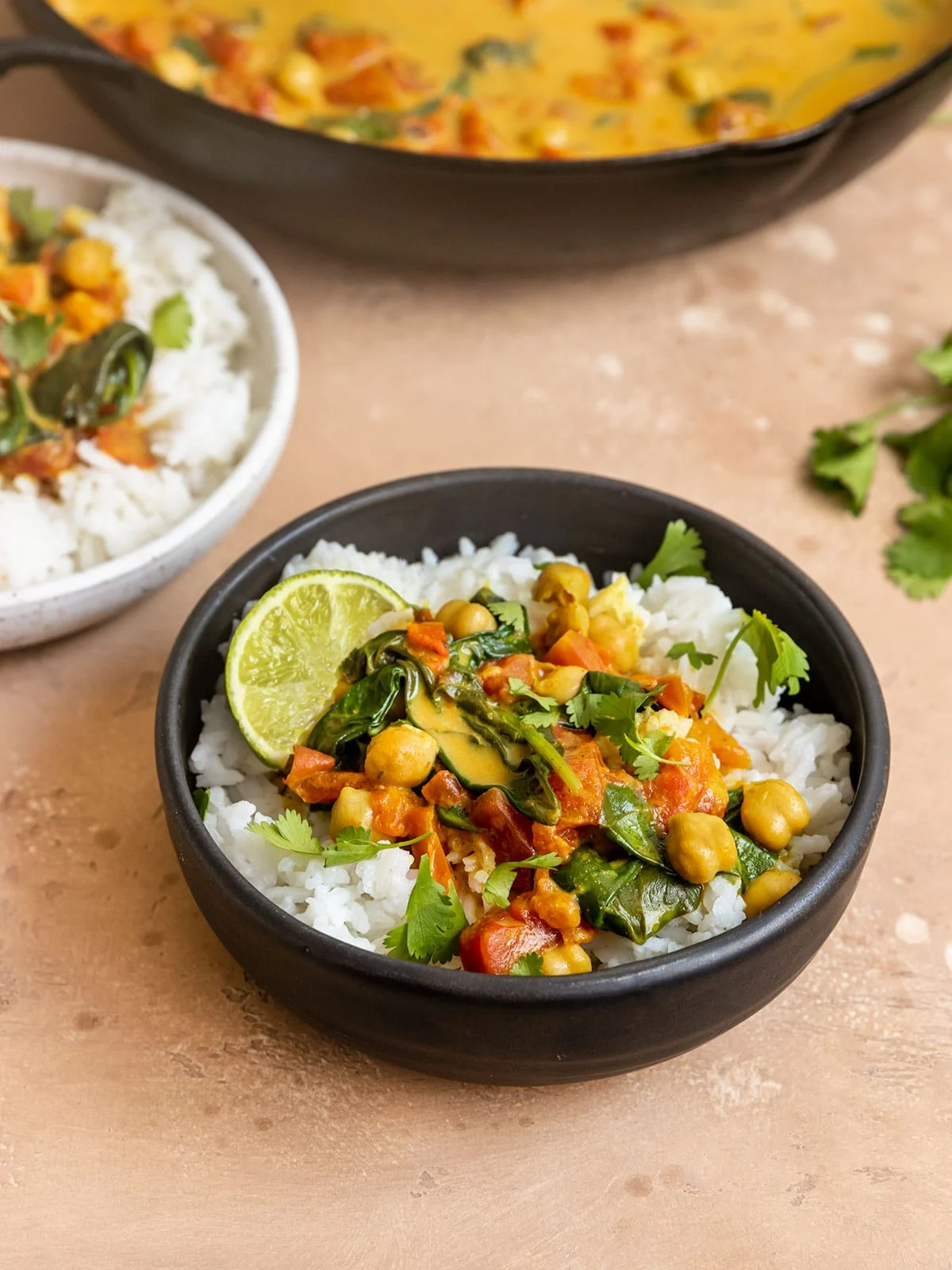
Chickpea Tomato Spinach Curry (Short Girl, Tall Order) is super-simple to make and you can store leftovers in an airtight container in the fridge for a few days, or freeze for up to a month (just defrost and reheat). Along with your basics (oil, seasonings, spices), all you need are canned chickpeas and chopped tomatoes, fresh spinach, lime juice and (optional) nutritional yeast (a cheesy-tasting B12 powder found in most stores). Garnish with fresh chopped coriander.
If made well, a homemade curry is almost a health supplement in a dish! You’ve got your fresh veggies, fresh herbs and spices (many like turmeric are anti-inflammatory). If you serve alongside wholegrain rice (or basmati if you find brown rice too heavy) and lay off oil-laden naan breads, it’s a great meal. Add some tempeh or lentils, and you get your protein and calcium too.
There are debates on where the word ‘curry’ originates, but most say it’s not from India. It’s either from the Tamil word for spicy soup sauce (‘kari’) or from the French verb ‘cuire’ which means ‘to cook’. What we do know is that England has a curry history dating back 200 years, with the first curry house opened in London back in 1810 (by an immigrant entrepreneur).
Like most food from abroad, the first ‘recipes’ were simply handed down by families. The first-ever published recipe in England (in a 1747 cookbook) says to ‘make a curry the India way’ by adding ‘black pepper and coriander to vegetables! Hot spices were not introduced until much later (it’s a myth that all Indians eat spicy food, a lot of the food is naturally mild). Curry spiciness is measured on the Scoville Scale. The hottest ingredient is Scorpion pepper that has to even have warnings on packets, as most people can’t tolerate the heat!
the most popular types of curry
Korma is the mildest curry that most people like. Create plant-based versions with cashew cream or coconut milk (free from monkey harvesting).
Tikka Masala is one of England’s most popular curry dishes, created in Glasgow by a Pakistani chef, back in the 70s. It combines spices with yoghurt/cream and chicken, though now there are plant-based alternatives.
Saag is from the Punjab area and contains spices and mustard leaves, and often uses ghee (a clarified butter). It’s one of the most popular meals in India, and usually includes spinach, ginger and garlic.
Palak paneer is similar to saag. Again it uses spinach and spices, but also includes cheese and yoghurt for more ‘tang’. It also is from the Punjab region.
Vindaloo is for the brave! This is a very spicy curry that is popular for ‘men who like hot curry’ but again it does not hail from India (it was invented in the Portuguese colony of Goa). However, it’s not the spiciest (that would be phal, created in a Bangladeshi Birmingham restaurant with ‘ghost peppers’). If you can’t tolerate spicy curry, you can ‘calm it down’ with plain plant-based yoghurt and eat a little bread (drink lemonade). Don’t drink water (it will just swish the spices around your mouth and make things even worse)

Thai curry is made with lemongrass, ginger and garlic, coconut milk (and often tofu) plus chilli peppers (yellow, green or red, depending how spicy you want to go). This Thai coconut curry soup (Ela Vegan) is made with veggies, coconut milk and curry paste, along with egg-free noodles.
Massaman curry is another Asian curry (from Indonesia – and less spicy). Rendang curry has less sauce, and often is slow-cooked to bring out the flavours.

Vegetable Curry with Pineapple (Ela Vegan) makes use of canned pineapple chunks, for a sweet not-too-spicy curry. Again this calls for basic ingredients: fresh veggies (carrot, courgette, peppers, aubergine), canned chickpeas, onion, garlic and spices. Along with canned coconut milk to make the ‘creamy sauce’.
a recipe for a creamy courgette curry

This creamy courgette curry recipe (The Veg Space) is super-simple to make, very affordable and tasty. A great way to use up a glut of leftover veg, the veggies are cooked with roasted garlic and ginger, then served with rice and naan bread.
Courgettes (called ‘zucchini’ in North America) are related to squash and generally are tastier the smaller they are (if not harvested, they grow to become marrows). Avoid buying ones with black spots or wrinkled/yellow skin. Tim Dowling writes how he poisoned himself with homegrown courgettes, which (due to bad batches of seeds) carry a toxin if cross-pollinated that causing a bitter taste. So choose certified organic if you can. Store them in the fridge.
If growing courgettes, make gardens safe for pets and use humane nontoxic slug/snail deterrence. Use wildlife-friendly netting alternatives (most is larger than recommended 0.5mm gaps).
essential homemade curry ingredients
The Teaspoon Club offers spice jars (hold 6 tablespoons) sold with refills in compostable packaging. All items are sent wrapped in easy-to-recycle tissue paper printed with eco-friendly inks. Spices include turmeric, cumin, cinnamon sticks, nutmeg, paprika and chili powder (many certified organic).
Most towns have a zero waste shop to take your own jar to fill up with rice, using a tare weight system (so you pay for food only, and not packaging). Or look in stores for Mr Organic rice (both this and their pasta is sold in paper packaging).
serve with homemade naan bread

Many people won’t even touch a curry unless it’s served with naan bread. This is good, but be careful as most supermarket versions (usually wrapped in tons of plastic) are made with palm oil and milk (so not for vegans). This naan bread (Ela Vegan) is made with gluten-free flour and plant yoghurt, along with a little baking powder, salt and oil. It also includes aquafaba (the leftover brine water from canned chickpeas) to make a ‘vegan meringue’ that keeps the naan breads light and airy.
Boom easy vegan curry kits
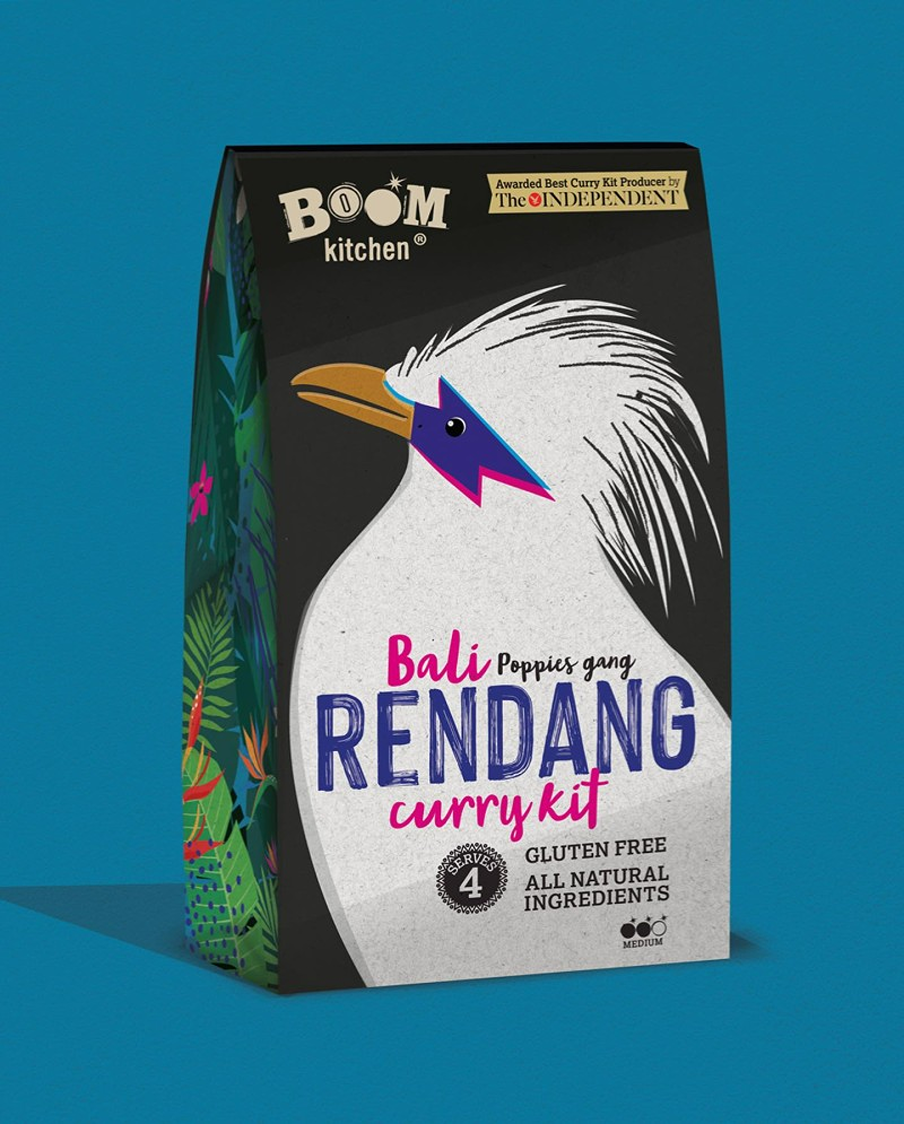
Boom makes it super-easy to make a curry, if you prefer not to make from scratch. A half-way house between make-your-own and ready-made, the founder spent his youth in Asia and knows how to make good curry. So each of the kits contain a natural onion gravy stock, a spice mix, coconut, whole spices and chillies. Choose from:
- Karma Korma
- Tikka Tarka Masala
- Magic Bhuna
- Jalfrezi Heatwave
- Lady Naga Vindaloo
- Ayubowan Sri Lankan
- Mellow Moroccan Tagine
Just add your fresh ingredients, make up your curry, then recycle the packaging at kerbside or in supermarket bag bins. Not as cheap as a homemade curry, but cheaper than a supermarket ready-meal and for sure, cheaper than takeout!
vegan frozen curries to your door
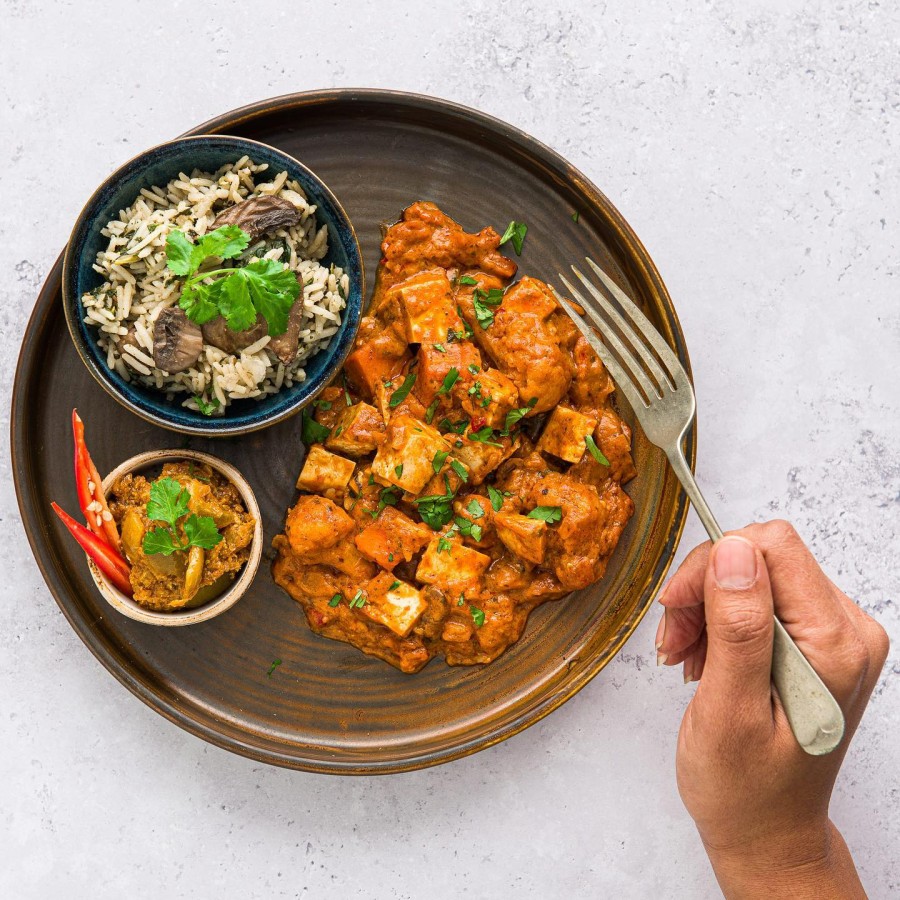
Root Kitchen is a great vegan meal delivery service, offering big (frozen) portions to your door as one-time orders or on subscription (you can pause if you go on holiday etc). Keep dry ice away from children and pets. The range includes:
- Tofu tikka masala (cauliflower and sweet potato in a creamy spinach sauce and mushroom Basmati rice)
- Spicy jalfrezi curry (onions, chickpeas, red peppers and green beans with cumin Basmati rice)
- Red Thai vegetable curry (baby corn, green beans, red peppers, sweet potato, water chestnuts and bamboo shoots, served with jasmine rice)

